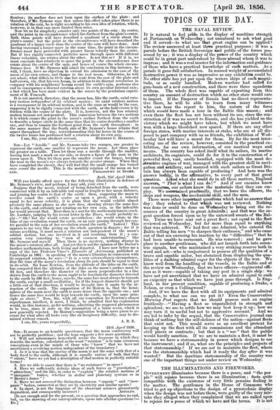Suppose that the moon , instead of being detached from the
earth, were connected with it by an inflexible rod equal in length to her mean distance, and joining her centre to that of the earth : then, supposing the moon to revolve round the earth's centre as upon a pivot, with a velocity equal to her mean velocity, it is plain that she would exhibit almost precisely the same phases as she now does, showing always the same face to the earth, and certainly not rotating on her own axis, as the inflexible bar would prevent that. Here then is a nut for the mathematicians to crack. Dr. Lardner' judging by his recent letter in the limes, would probably re- ply—" Oh ! but she would rotate nevertheless : she would rotate in the time of one revolution round the earth, on an axis passing through her cen- tre parallel to the axis of her revolution round the earth." Indeed ? This appears to me very like giving up the whole question in dispute ; for if it means anything, it must mean a rotation not independent of the moon's orbital motion, but one involved in it and resulting from it ; a con- cession very consoling to " men of common understanding," like Mr. Symons and myself. Then there is no mystery, nothing strange in the moon's rotation after all. And yet this is not the opinion of the Doctor's brother mathematicians, both living and departed. I have now before me a copy of the late Professor Vince's Elements of Astronomy, published at Cambridge in 1801: in speaking of the moon's libration in connexion with its supposed rotation, he says—" It is a very extraordinary circumstance, that the time of the moon's revolution about its axis should be equal to that in its orbit: Sir Isaac Newton, from the altitude of the tides on the earth, has computed that the altitudes of the tides on the moon's surface must be 93 feet, and therefore the diameter of the moon perpendicular to a line drawn from the earth to the moon ought to be less than the diameter directed to the earth by 186 feet ; hence, says he, the same face must always be towards the earth, except a small oscillation ; for if the longest diameter should get a little out of that direction, it would be brought into it again by the at- traction of the earth. The supposition of Dc Mairan is, that the herni- s.phere of the moon next the earth is more dense than the opposite one ; and hence the same face would be kept towards the earth, upon the same prin- ciple as above." Now, Sir, with all our veneration for Newton's almost superhuman intellect, it must, I think, be admitted that his explanation would, in this instance, go for nothing, admitting the supposed phenomenon to 'be true, since it rests on the assumption of a lunar ocean, which is now generally rejected. De Mairan's supposition being a mere guess to ac- count for what after all looks very like an imaginary difficulty, may be dis- missed without remark.


























 Previous page
Previous page